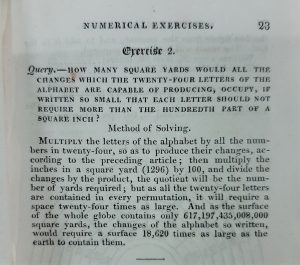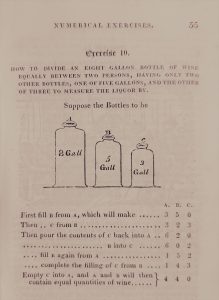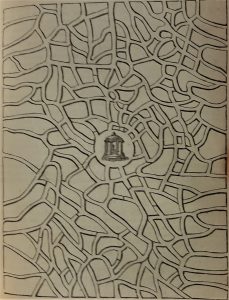July 30, 2021, by Kathryn Steenson
Are you smarter than a 19th century 10 year old?
“My first is to ramble, my next to retreat; my whole oft enrages in summer’s fierce heat”.
Any suggestions? This word puzzle sounds like a cryptic crossword clue but it’s actually a fun puzzle for children. The answer is at the bottom of the post, but if you didn’t solve that one, try this:
“Without my first, my second would be undone; my whole’s a village near Hyde Park and London”.
This one is harder, as I don’t think anyone has considered this place “a village near London” for probably 150 years. Perhaps a more helpful clue would be “My whole is a station in Travel Zone 2”, even if it doesn’t rhyme.
The anagrams might be more accessible for modern readers. The fact that they are intended for an audience of boys should hint broadly at what type of topics they cover, but also each anagram is itself a clue to the word:
- No more stars
- Golden land
- Lame
Answers at the bottom of the page.
These riddles and anagrams are products of their time, which was 1828, when this 4th edition of ‘The Boy’s Own Book’ was published. Billed as a complete encyclopaedia of all the diversions (athletic, scientific, and recreative), it had lofty ambitions to help boys develop the skills they would need as men in the guise of entertainment. We have looked at some of the practical science exercises in other, similar books for boys, and they include such terrifying activities as manufacturing stovetop fireworks and invisible ink with lead.
Numerical problems were also included, though I have my doubts that many children were excited at additional maths homework. Simply reading this maths question from a similar book, ‘Rational Recreations: the most marvellous scientific experiments, the most astounding feats of legerdemain, the most puzzling numerical exercises” feels like a feat of endurance in itself .

Reading this is like having one of those nightmares where you have to sit an exam without having had time to prepare or find clothes. Ref: Rational Recreations (1825); Briggs Collection LT210.GV /R2
In hindsight, the use of the word ‘legerdemain’ in the title should have been a clue as to the level at which this book was pitched. Now this numerical exercise, from the same book, is more my type of maths: wine storage conundrums.

Finally, a maths curriculum that is relevant to daily life. Ref: Rational Recreations (1825), Briggs Collection LT210.GV /R2
Not that it makes any difference to the calculation, but wine gallons are different from the imperial gallons. This book was published in 1825, around the time that all gallons were abolished except for the imperial gallon. The wine gallon was slightly larger, but no child will complain of being thirsty after drinking 4 gallons of wine, regardless of which type of gallon it is.
And finally, a puzzle better suited both to my abilities and my idea of fun: a maze. This is still educational, as it is based on the legend of Rosamund Clifford, mistress of King Henry II. According to folklore, in order to hide their trysts from the Queen, Eleanor of Aquitaine, they met in a labyrinth. The affair is factual, the maze and any of Rosamund’s increasingly fanciful deaths at Eleanor’s instigation (poison, dagger, burning) are probably not. In this maze, poor Rosamund sits in her bower and waits for the handsome young gentleman who owned the book to find her. There are faint pencil markings which also make it one of the few puzzles we know for sure was attempted.
These books are taken from the Briggs Collection of Children’s Literature, and can be viewed in the Reading Room on King’s Meadow Campus by appointment. See our website for details about how to book a visit and for links to the catalogue of all our holdings.
Answers
Riddles:
- Gadfly
- Hammersmith
Anagrams:
- No more stars = astronomers
- Golden land = Old England
- Lame = male. Either the authors broke the pattern and didn’t intend the anagram itself to be a clue, or they were being a little harsh to men.
No comments yet, fill out a comment to be the first



Leave a Reply